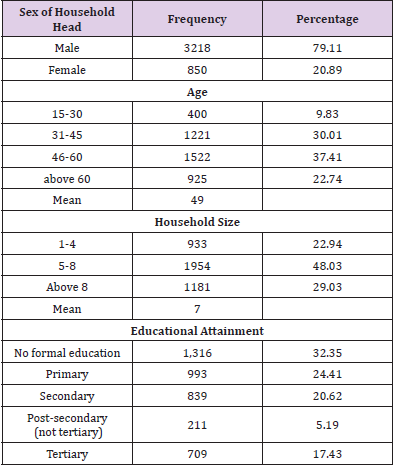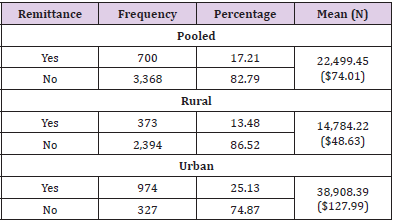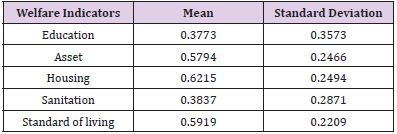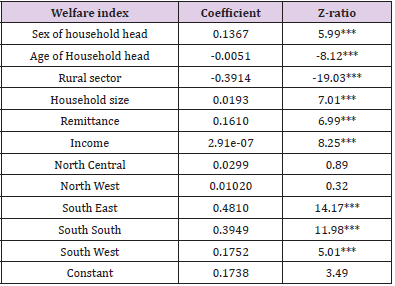Does Access to Remittance Improve Welfare Status of Households in Nigeria?
Introduction
Remittance is defined as the proportion of migrants’ earnings sent from their destination of employment to their origin or communities (Samal [1]). They also are considered as compensation (brain gain) for the loss of human capital (brain drain) by a net labour exporting country (Ratha, et al. [2]). Remittances can be categorised as monetary versus non-monetary remittances; domestic versus international remittances, and inward versus outward remittances. Remittances have attracted attention in empirical studies with some concentration on their determinants and developmental impacts (Adenutsi [3]). Developing countries as a whole have consistently been the largest recipient of international remittances in the world. Between 1995 and 2005 the total amount of official migrant remittances received by developing countries increased by more than 300% (Adenutsi [3]). Remittances to developing economies reach US$338 billion in 2008, higher than its estimated value of US$328 billion (World Bank [4]). They are person-toperson flows, well targeted to the needs of the recipients, who are often poor, thereby assisting poor families deal with negative economic shocks (World Bank [5]). This makes remittances very important source of finance for the rural households traditionally known for high level of poverty (low welfare level) and low access to foreign aid, government grants or bank loans.
Remittances enable the hitherto risk averse farming households insured by remittances, to shift their portfolios towards riskier enterprises, an indicator of welfare (Chukwuone, et al. [6]). Adams [7] noted that increased workers’ remittance inflow reduced income inequality among households in rural Egypt. Adams [8] further established that remittances reduce the severity of poverty in Guatemala, with households spending greater percentage of income on durable goods than on non-durable goods. Taylor, 2005, submitted that international migrants’ remittances increased per capita income of households and reduced the incidence and depth of poverty in Guatamala. In addition, it improves human capital indicators (education and health) of the recipient countries Fajnzylber, et al. [9]. Increased per capita income, reduced poverty incidence, improved health, asset acquisition and human capital developments are all indicators of Welfare, which is synonymous with good quality of life (Narayan, et al. [10]). However, there are empirical facts that households domiciled in the rural sector received significantly less remittances than their urban counterpart did. It was also established that only between 30 and 40 per cent of all remittances are destined to rural areas (Netri, 2010), where the majority of the population lives. Such disparity in remittances distribution among household categories makes the effect of remittance on welfare unequal.
Thus there is need to examine the effect of migrants’ remittance on the welfare status of households in Nigeria. This encompasses examining the sectoral disparity in migrants’ remittances and welfare status of the households; and the contribution of remittances and indicators of welfare to the overall welfare status of the households. Lastly, the study will establish whether migrants’ remittances have significant effect on the welfare status of households in Nigeria.
Methodology
The study area is Nigeria, West Africa. The source of data is from the Living Standard Measurement Survey (LSMS, 2015/2016) collected by National Bureau of Statistics. Total respondents of 4,068 households were sampled and used for the analysis. The methods of analysis of data adopted are descriptive statistics, Multidimensional Welfare Index and Tobit regression model. Descriptive statistics was used to analyse the socioeconomic characteristics of the respondents and the amount of remittance received by households. Fuzzy set was adopted to estimate the multidimensional welfare status of each household in Nigeria. The Multidimensional Welfare Index (MWI) is a measure of acute global welfare developed by the Oxford Welfare and Human Development Initiatives (OWHI) with the United Nations Development Programme’s Human Development Report (UNDP, et al. [11-14]. The index method belongs to the family of measures developed by Alkire [15]. This method requires determining the unit of analysis (i.e. household), identifying the set of indicators in which they are deprived at the same time and summarizing their welfare profile in a weighted deprivation score. The households are identified as multidimensional worse off if their deprivation score is below a cross-dimensional welfare cut-off. The number of worse off people and their deprivation score (i.e. the percentage of simultaneous deprivations they experience) become part of the final welfare measure.
The constructed Multidimensional Welfare Index (MWI) is based on five dimensions: education, sanitation, standard of living, housing and asset, which were carefully selected as guided by literatures (following Pampalon, et al. [16-18]):
1. Education
2. Sanitation
3. Standard of living
4. Housing
5. Assets
Fuzzy set involves constructing an index from array of items that could be linked to welfare (attributes of welfare). Costa [19], citing Dagum, (2002), gives an exposition of the methodological framework of fuzzy set theory. Given a population A of a households, A = {a1, a2, …, an}, the subset of worse off households B includes any household a1∈B which presents some degree of welfare in at least one of the m attributes of X, The degree of membership to the fuzzy set B of the i-th household (i=1,…, n) with respect to the j-th attribute (j=1,…, m) is defined as;

X = 1, if the i-th household possesss the j-th attribute and ij x = 0, if the i-th household does not possess the j-th attribute. The multidimensional welfare ratio of the i-th household ( ) B i μ a , i.e the degree of welfare of the i-th household as a weighing function of the m attributes, is defined as the weighted average of ij x ,

Where Wj is the weight attached to the j-th attribute. The weight wj attached to the j-th attribute stands for the intensity of deprivation of Xj . It was proposed by Cerioli, et al. [20] and can be represented with the following expression:

The multidimensional welfare ratio of the population μ B is obtained as a weighted average of the welfare ratio of the i-th household μB(a1).

Fuzzy set framework also follows obtaining one-dimensional welfare ratio for each of the j attributes. This is the weighted average of xij with weight ni.

It is also possible to obtain the multidimensional welfare ratio of the population μ B as the weighted average of μ B( Xj) (unidimensional welfare ratio of the attributes), with weight wj .

In order to determine the effect of migrants’ remittances on the welfare status of households, Tobit regression model was used since the values of the endogenous variable lies between zero and one with none having zero value. The household welfare threshold was put at 0.5 according to (UNDP [11]) the model for the regression analysis is specified thus,
1. Y1 = ∝1+β1 X¬1+β2 X2+……….βnXn+ ei
2. Yi* = Yi if 0.5 ≤Yi≤1 (better off)
3. Yi* = 0 if Yi < 0.5(worse off)
4. Y = dependent variable
5. ∝= Intercept term
6. β i = parameters to be estimated
7. Xi = Vector of explanatory variables
8. ei= Disturbance term assumed to be independently and normally distributed with zero mean and constant variance
The dependent variable (Y) is the welfare index while the explanatory variables are as follows:
1. X1 = Age of household heads (years)
2. X2 = Gender (dummy) – male 1, female 0
3. X 3 = Household size (number)
4. X4 = Household remittance (Naira)
5. X5 = Sectors (rural 1, urban 0)
6. X6= Household income (Naira)
Geopolitical Zones
1. X7 = south-west 1, 0 otherwise
2. X8 = south-south 1, 0 otherwise
3. X9 = south-east 1, 0 otherwise
4. X10 = north-east 1, 0 otherwise
5. X11= north-central 1, 0 otherwise
6. X12= north-west 1, 0 otherwise
Table 1 profiles the socioeconomic characteristics of the households in Nigeria. Male respondents head almost eight out of every 10 households in Nigeria. The mean age of the respondents (49 years) revealed that majority of the respondents are in their energetic and resourceful age. This is in consonance with the submission of Ashagidigbi, et al. [21] who reported that average age of household heads in Nigeria is below 50 years. Households in Nigeria have an average of seven members indicating a relatively high household size, corroborating the finding of Ashagidigbi, et al. [22] who stated similar value. About one-third of the entire population does not possess formal education. In other words, significant proportion of households possesses one form of formal education or another. The access of households to remittance is depicted in Table 2. In the pooled data, 17% of the entire households received remittance from their kith and/or kin in Nigeria. However, 13 out of every 100 respondents have access to remittance in the rural sector of the country, while a quarter receives remittance in urban sector. This reveals that access to remittance by households in Nigeria is low. A household on the average earns $74 as remittance in Nigeria; value of urban remittance is 73% higher than that of the pooled data, while that of rural sector is 34.3% lower. The figures are considerably low due to the inaccessibility of majority of Nigerian residents to remittance, specifically those residing in rural areas of the country.
This supports the finding of (Kshetri, et al. [23]), who established that rural households received between 30-40 percent of total remittance in Africa. As relayed in Table 3, five indicators contributing to the overall welfare status of households in Nigeria were considered. Housing is the leading contributor, responsible for 62.15% of the households’ welfare status. However, education and sanitation are the least contributing factors contributing 37.73% and 38.37% respectively to the welfare status of households in Nigeria. Thus, emphasising that education and health/sanitation issues still pose considerable challenge to households resident in Nigeria.
In the pooled data, the welfare index of the households is 0.51, similar to that reported by Ashagidigbi et al, 2019 (0.58). The value is higher for households resident in urban sector of the country, while the rural resident is far below the country’s mean value. Across the sectors, the welfare status of remittance-receiving households in urban sector is better off than those in rural sector and Nigeria as a whole (Table 4). Similar trend is observed for the non-remittance receiving households. However, households that receive remittance have better welfare status in the pooled data and across the sectors than non-remittance receiving respondents. The finding aligns with that of Taylor, et al. [24], who posited that remittances reduce the incidence and depth of poverty among households in rural Mexico.
Table 5: Effect of Remittance on Households’ Welfare Status in Nigeria.
Note: Log likelihood = -2832.7946
Prob > chi2 = 0.0000
This clearly shows that remittance is a significant factor positively influencing welfare status of households in Nigeria. Tobit regression model was adopted to analyse the effect of remittance on welfare status of households in Nigeria Table 5. Age, sex, household size, income, remittance and sector where the respondents reside are the factors that significantly influence households’ welfare status at one percent level of probability. Others are northcentral, southeast, southwest and south-south zones. A naira increase in income and amount of remittance received increases the welfare status of households by 2.91e-07 and 0.16 respectively. This is an indication that households that receive remittance have higher likelihood to be better off in relation to their welfare status compared to the households that do not receive. This submission is in tandem with (World Bank [4,5] where it was reported that access to remittance by households avail them the opportunity to cope with negative economic shock. Likewise, (Pfua, et al. [25], Adams [8]) submitted that remittance assists in improving the living condition and reduce severity of poverty of the recipients, most especially the poor households. The welfare status of higher income earning households are better off relative to the lowincome earners. A unit increase in age of the respondents reduces households’ welfare status by 0.51%, while an additional member to a household increases households’ welfare status by 1.93%. This submission establishes age as a welfare-reducing factor, while household size is regarded as welfare enhancing variable.
Furthermore, the welfare status of residents in the northcentral, southeast, southwest and south-south zones of the country increases by 2.99%, 48.10%,39.49% and 17.52% respectively, relative to the northeast residents. This aligns with Ashagidigbi, et al. [26] who concluded that inadequate access to better welfare is prominent among the northeast and northwest residents in Nigeria [27] Likewise, rural dwellers’ welfare status reduces by 39.14% in comparison to urban residents. This implies that the welfare status of households residing in urban sector and other zones with the exception of northeast are far better off. Hence, rural and northeast residents should be of primary focus when implementing poverty reduction measures in Nigeria.
Conclusion
The facts deduced from the study are that majority of households in Nigeria do not receive remittance (83%). The scenario is worse in rural areas compared to the urban sector. Among the indicators of welfare, housing contributes the most to the overall welfare of the households, while education and health/sanitation contribute the least. The welfare status of households receiving remittance is considerably higher than non-remittance receiving households in the pooled data and across the sectors. However, the welfare status of households that receive remittance in urban sector is better off than rural sector residents. Remittance positively influences the welfare status of the households. On the contrary, households residing in rural sector and northeast zone of the country are worse off in relation to their welfare status. Sector and zone specific policy measures that could ease and enhance the access of residents in the rural sector and northeast zone to remittance is paramount in ensuring improved welfare status among households in Nigeria.
For more Articles on: https://biomedres01.blogspot.com/







No comments:
Post a Comment
Note: Only a member of this blog may post a comment.